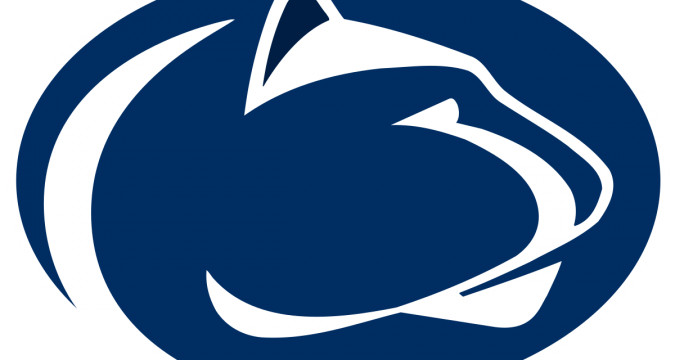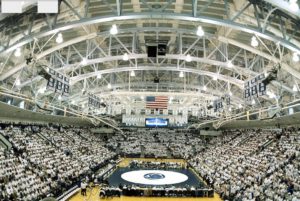
During his wrestling career, and in the years since, Dave excelled wherever he set his focus-be it on or off the mat. He was an NCAA runner-up at 147 pounds in 1956. He was an EIWA champion in 1957 and he also was a co-captain of the team in 1957. After graduating from Penn State he was the head coach at the University of Pittsburgh. Later in his career he was an Athletic Director first at San Jose State and then at the University of Akron. Dave is one of only nine coaches to have been named to the EWL Coaching Hall of Fame.
Dave how did you get started in wrestling?
In 1946, Glen Smith, a former Penn State wrestler, started a wrestling program at Bellefonte High school. He visited all the elementary schools that fed into the high school. At that visit, he gave a talk about wrestling, explaining what wrestling was and inviting anyone who was interested to come see the meets. When the season was over, he said that he would continue to have practices on Tuesday and Thursday nights. Since one of my neighbors was on that first high school team, I went to see several of the matches and followed up by hitch-hiking 6 miles Tuesdays and Thursdays that spring to learn about the sport. In the 7th grade, I went out for the team and wrestled several exhibition matches. I guess the rest is history…
Tell us about your high school wrestling career.
I made the team as a 103 pounder as a freshman and started my career with a 6-4 loss. I went the rest of the dual-meet season undefeated and won the district championship. From the districts, we went right to the states; I won my first match and then lost to the defending state champion in the semi-finals by an 8-7 score. My sophomore year, I moved up to 120 pounds; I defeated the defending 112-pound state champion in my first meet and finished the season undefeated, winning the districts, regional and state championships. During my junior year, I wrestled 127 pounds and lost one dual meet and then lost again in the semi-finals of the state meet to the eventual state champion by a 5-4 score. My senior year, I moved up to 138 pounds and ran through the season undefeated, again winning the district, regional, and state competitions. During this time, I also participated in the state YMCA championships in 1951 and 1952, winning at 123 and 130 pounds respectively.
Talk about the process that brought you to Penn State.
My father and three uncles were all graduates of Penn State, and my brother had started matriculating to the university. In addition, I was born and raised 10 miles from the campus. I was always cognizant of what was occurring within Penn State’s athletic program. I had a third-grade teacher whose husband was in charge of Penn State’s athletic department’s ground crew. She had high hopes of channeling my energy towards athletics, thus taking me to numerous PSU sporting events. Also, I worked out with the Penn State wrestlers on several occasions and got to know a number of them on a personal basis. They helped to influence my decision.
Who was the toughest guy you ever wrestled in college?
Pure toughness was a guy by the name of Larry Tenpas, the 1956 NCAA 157-pound champion from Illinois. He was just a physical horse and tough as nails. Another one who gave me troubles was Ed Eichelberger, a two time NCAA champion from Lehigh. To this day, I wish I had had the opportunity to go a few more rounds with him.
What are your best memories from the years you spent as a Penn State wrestler?
The teammates that I had and the associations that I developed with the fans provide great memories. The older I have gotten, the more I realize what a true family atmosphere is provided to a Penn State athlete. I have developed many associations over the years, due to my affiliations with Penn State, which make me proud to be a Nittany Lion.
Dave, tell us about your life since you graduated from Penn State.
I stayed on at Penn State as a graduate assistant, serving as the assistant wrestling coach for one year. During that time, I earned my master’s degree. Then I took a job teaching junior high science and serving as an assistant football coach and head wrestling coach at Boiling Springs High School. From there, I returned to Penn State and taught physical education and served as the assistant wrestling coach for five years. My next position took me to the United States Naval Academy in 1954 where I was an assistant professor in physical education, plebe wrestling coach, and assistant baseball coach. Three yeas later, I accepted the job as head wrestling coach at the University of Pittsburgh. In 1975, I was promoted to assistant AD in addition to my coaching duties at Pitt. Then in 1980, I was appointed as the AD at San Jose State University. This was followed by returning east to the University of Akron as the AD in 1985. In 1988, I moved to the position of assistant to the vice-president for administrative services.
In 1970, I was appointed to the position of secretary/editor of the NCAA Wrestling Rules Committee and served in that position for 19 years. In 1975, I was assigned as the chief of operations for the head table at the NCAA Division I Championships and continued in that position for 36 years. I retired from that duty last year after the meet in Philadelphia.
In 1992, I came out of retirement to take a position as director of college marketing and sales for Team Dynamics. This job entailed developing a college program for a company that had focused on high schools. Our main product was temporary tattoos, and we also handled other spirit items. I enjoyed this work for about six years.
How has the Penn State wrestling experience impacted your life/career?
My high school experiences coupled with my wrestling career at Penn State gave me a deep love for the sport of wrestling. Simply look at my resume; it reflects a life filled with wrestling in some aspect. I am still a die-hard Penn State fan; I follow all PSU sports very closely and keep in touch with many of the acquaintances that I have developed over the years.
Talk about the years you spent as head wrestling coach at the University of Pittsburgh.
One of my life’s ambitions was to be a head wrestling coach; by moving to Pittsburgh, I was able to fulfill that goal. I thoroughly enjoyed the day-to-day contact with the students and was proud of their accomplishments as athletes and young adults. This position also allowed me to move from coaching to administrative duties which was an area in which I had great interest. (As a side note, both of my daughters received their education from the university during my tenure there.)
What was the most satisfying aspect about being a college athlete director?
I thoroughly enjoyed working with coaches–a change from working directly with the athletes. Getting involved with fund raising and budgets offered new challenges. Also, direct involvement with the conferences and the NCAA provided new, welcomed opportunities.
One of the more satisfying situations was moving the athletic program at the University of Akron from Division I-AA to Division I-A. This was the first time that any program had made such a change in classification. Since it had not been done previously, there were no guidelines specifying the criteria that needed to be met. After several meetings with the NCAA folks, we established the necessary changes that had to occur and then made the move to Division I-A.
Could you share some stories from your years you ran the head table at the NCAA championships?
You don’t have enough space in a single article for the answer to this question; I could provide you with a novel. It was never easy to inform a coach that an individual on his team had received a warning or a penalty; this judgment could apply to an athlete, the coach, or trainer. The result of such penalty could be the loss of team points or the dismissal of the individual from the venue. Coaches didn’t always receive this information with dignity or grace. I won’t miss this aspect of the job; however, many stories about those moments will remain.
Talk about the Cael Sanderson era Nittany Lion wrestling program.
I believe it is rather obvious that those responsible for making the decision of hiring Cael Sanderson made the correct choice. I cannot fathom anyone doing as well as he has up to this point. The staff that he has put in place is the best one in the country, in my opinion. It appears that Penn State is taking its place as one of the premier wrestling programs, both presently and in the future. Not only has Cael’s staff done an outstanding job coaching the PSU grapplers, but their recruiting has been superb.
How has collegiate wrestling changed since you were a wrestler at Penn State?
It has gone from a seasonal sport to a year-round sport. As a result, the technique has greatly improved. The rule changes have reduced the emphasis on mat wrestling and placed more importance on take downs.
What does Penn State wrestling mean to you?
Penn State wrestling is embedded in my soul. Not to distract from my high school experiences, but it is where I began my journey in collegiate athletics. That journey lasted thirty-six years. Perseverance and determination were developed as a young athlete on that campus, and those qualities have lasted a lifetime.
What advice do you have for collegiate wrestlers today?
First and foremost, enjoy the journey. It is way too short, and those years of active competition pass in the blink of an eye. Learn all you can from coaches and those around you. Practice as you want to compete. Everyone wants to be a champion, but few are willing to pay the price to prepare to be that champion. This will take time and dedication, but the sacrifices will be worth the rewards. Above all else, don’t ignore academics for athletics; it’s important to have a determined focus in both areas.
What makes wrestling a great sport?
Unlike other sports, you are in the adventure alone when on the mat. Although a coach or teammates may be near by, you must take full responsibility for your own actions. This develops independence and, hopefully, self-confidence. When one move doesn’t result in the desired success, the wrestler must make adjustments. This results in developing perseverance and flexibility.

